Gandara
Q213651Gandara (Old Persian Gandâra): name of a satrapy of the ancient Achaemenid Empire, roughly equivalent to the valley of the river Cophen (modern Kabul). The Greeks called the western part this region Parapamisos, which may be derived from the old Old Persian name of the Hindu Kush mountain range, Upairisaena. Culturally, Gandara belonged to the Indian, not to the Persian world.
The country
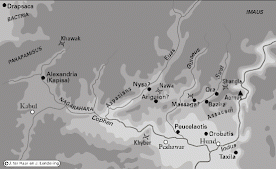
The valley of the Cophen is on three sides (North, West, South) surrounded by mountains, but there are accessible passes. As a consequence, Gandara could become an important link between India and Mesopotamia. The oldest indications for cultural contact between the ancient Near East and the Far East are about six thousand years old.
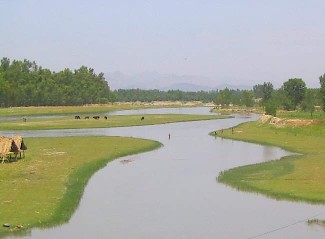
Coming upstream from India along the Cophen, the traveler's road forked some fifty kilometers east of modern Kabul.
- He could go to the southwest along the river Lowgar, where he could cross the Altimur pass, reach the region along the Tarnak river and arrive in Arachosia.
- He could go to the northwest along the river Ghorband. If he wanted to go to the west, he had to cross the Hajigak pass and reach the upper valley of the Etymandrus river, the modern Helmand Rûd. Following its course, he would eventually arrive in Drangiana.
- North of the Ghorband, there were several passes across the Hindu Kush. On the other side were rivers flowing to the great Oxus, the modern Amudar'ya. This country was called Bactria.
A ruler who controlled Gandara, controlled the road from the Indus valley to eastern Iran and the plains of the Amudar'ya. Its strategic importance has been the cause of several important wars in this region. Among the invaders were the Indo-Iranians in the first half of the second millennium BCE, the Persians in the third quarter of the sixth century BCE, the Macedonians under Alexander the Great (329; below), the Graeco-Bactrians (184; below), the Sacae (c.110 BCE) and the Kushans.
Persian rule
The Persian invaders of Gandara were commanded by king Cyrus the Great (559-530). Although there is no source that describes this event, we may be confident that it happened, because king Darius the Great (522-486) mentions Gandara as one of the countries he inherited when he became king (in the Behistun inscription).
The capital of Gandara was later called Kapisa. The city was strategically situated: it controlled the roads to the Etymandrus valley, to the Cophen valley and to the passes leading to Bactria. Its modern name is Begram and it lies 75 kilometers north of Kabul, near Chârikâr.
According to the Greek researcher Herodotus of Halicarnassus (fifth century BCE), the Gandarians belonged to the seventh (and poorest) tax district of the Achaemenid empire, together with three other tribes, the Sattagydians, the Dadicae and Aparitae.note He dates his list of tax districts during the reign of king Darius.
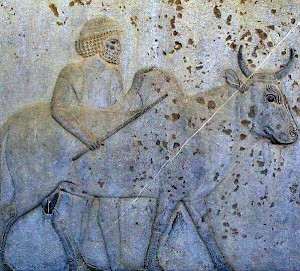
It is certain that Darius sent out a Carian named Scylax of Caryanda to describe the eastern territories of his empire. He started his tour in a town called Caspatyrus, which must have been situated somewhere on the banks of the Cophen. In those years, the satrap of Gandara was Megabazus, who had been fighting in Europe after 513.
A generation later, we hear again about Gandara. Herodotus mentions how a contingent of Gandarian and Dadican soldiers was ordered to fight in Greece in 480 BCE.note
This is the last time Gandara is mentioned in our sources for about a century and a half. There is one exception: we know that yaka-wood was transported from Gandara and Carmania to Susa, where a new palace was built. It is not clear what yaka-wood may have been (perhaps teak-wood?), but it must have been very precious. In the palace at Persepolis, pictures of Gandarians can be seen. They carry swords and shields and take buffaloes to the great king.
Alexander in Gandara
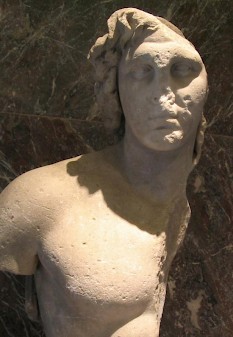
In the Spring of 336, an army of Macedonians and Greeks invaded the Achaemenid empire, which suffered from a dynastic conflict. The Persians were able to keep their enemies away, but in 334 the new Macedonian king Alexander the Great joined his troops. In November 333 and on 1 October 331, he defeated the Persian king Darius III Codomannus at Issus in Syria and Gaugamela in Assyria. Our sources do not mention Gandarians in Darius' army, which can be explained in four ways: (a) Alexander surprised the Persians before they had gathered their army; (b) Darius had not recruited Gandarians; (c) the Gandarians were known under an other name; (d) Gandara was no longer part of the Achaemenid empire.
The first explanation is not plausible: more than five years had passed between the invasion and the decisive battle at Gaugamela. The second explanation is unlikely, too, because the Persian king usually recruited units from all countries. It enabled him to show his power to the enemies and the Persian elite (e.g., king Xerxes took many soldiers with him to Greece, even though some men must have been quite useless). The third explanation may be correct, because we read about 'Mountain Indians', who are otherwise unknown. But probably the fourth explanation is the best, because it receives confirmation from the fact that the biographers of Alexander do not mention Persian satraps.
In the first months of 329, Alexander refounded Kapisa. It was called Alexandria and surnamed 'in the Caucasus' to avoid confusion with other Alexandrias. There must have been other towns, which for centuries remained recognizably Greek.
In 329-327, Alexander was fighting in Bactria and Sogdia; in 326, however, he was back in Gandara, where he met with Indian representatives who invited the Macedonian king to come to the Punjab. Alexander divided his army: his friend Hephaestion led an army along the Cophen (through the Khyber pass) and reached the Indus; Alexander took a more northerly route, along the rivers Kunar and Swat, where his men killed almost every Gandarian they met in a campaign that was little short of genocide.
During the war in the Cophen valley, the Macedonians captured a city named Peucelaotis (modern Charsadda). This may once have been the center of the Persian administration, but the historians who describe Alexander's campaign, describe it as an Indian town. Again, this suggests that Gandara had become independent. Peucelaotis is known in Indian sources as Puskalâvatî, "the city of lotus flowers".
The mountain Meru
Our sources on Alexander are focussed on warfare, but they give some information about the Gandarians too. Their towns were surrounded by brickwork fortifications, they fought with spears and arrows -no swords and shields are mentioned- and their leaders wore cuirasses. They had beautiful buffaloes (Alexander wanted to send them to Macedonia), and their towns were ruled by an aristocracy. Once, a queen is mentioned. And the Gandarians buried their dead in wooden coffins, which were placed on the hills around their towns. This custom still exists among the Kafirs, a local tribe near Chitral.
One of the strangest aspects of Alexander's campaign in Gandara is the discovery of the town Nysa and the mountain Meros. The place cannot be localized with absolute certainty. According to the Macedonians and Greeks, this was the place where the god Dionysus was born. Indian sources speak about Meru, the central mountain on which the world rested. The god that was worshipped on the Meru and was identified with Dionysus, may have been Shiva or Vishnu.
There is one description of the sanctuary, which must have played an important role in the religion of the Gandarians. It can be found in the Life of Apollonius of Tyana by the Greek author Philostratus (c.175-c.245). This Apollonius was a charismatic teacher who, according to his biographer, visited India in the first century CE. It is not clear whether Apollonius did indeed visit Gandara, but it is certain that Philostratus used a document that contained reliable information about India.
Apollonius and his disciples crossed the river Cophen, themselves in boats, but the camels by a ford on foot; for the river had not yet reached its full size here. They were now in [the country] in which the mountain of Nysa rises, covered to its very top with plantations [...], and you can ascend it, because paths have been made by cultivators. They say then that when they ascended it, they found the shrine of Dionysus, which it is said Dionysus founded in honor of himself, planting round it a circle of laurel trees which encloses just as much ground as suffices to contain a moderate sized temple. He also surrounded the laurels with a border of ivy and vines; and he set up inside an image of himself, knowing that in time the trees would grow together and make themselves into a kind of roof; and this had now formed itself, so that neither rain can wet nor wind blow upon the shrine. And there were sickles and wine-presses and their furniture dedicated to Dionysus, as if to one who gathers grapes, all made of gold and silver. And the image resembled a youthful Indian, and was carved out of polished white stone.note
After Alexander
Alexander conquered the Indus valley and returned to the west, where he died on 11 June 323. His kingdom was divided between his generals; Gandara and the other eastern provinces were given to Seleucus, the first king of the Seleucid empire. But his position was threatened in the west and he needed an army to defend himself; therefore, in 304, he conducted negotiations with to the Indian king Chandragupta (321-297), whose capital was Patna on the Ganges (304). Seleucus gave up the eastern satrapies, and in return received a great number of elephants - five hundred, according to the ancient tradition - which made him invincible on the western front.
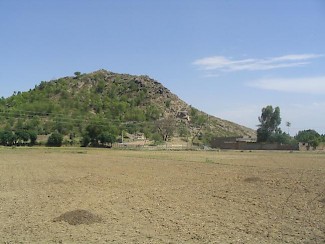
From now on, Gandara was part of the Indian empire that is known as that of the Mauryan kings. But Gandara remained open to Greek influences and the successors of Chandragupta and Seleucus continued to exchange ambassadors. The Mauryan king Ashoka (272-232), who conquered almost the entire subcontinent and converted to Buddhism, announced his rock edicts not only in Indian, but also in Greek - at least in Gandara and Arachosia, which suggests that there was still a strong presence of Yavanas (Greeks).
After 240, the Bactrian leaders, who were of Greek descent, revolted from their Seleucid overlords, but king Antiochus III the Great restored order (206). Soon after, however, Antiochus was defeated by the Romans, and the Bactrian leader Euthydemus declared himself independent. Not much later, the Graeco-Bactrian kingdom expanded into Drangiana, Gandara and the Punjab, where Mauryan power was now in decline.
This invasion, which took place in 184, revitalized the Greek culture in the region south of the Hindu Kush, where Euthydemus' son Demetrius created a new kingdom, consisting of Gandara, Arachosia, the Punjab and a part of the Ganges valley (Delhi). It was a multi-ethnic society, in which Greeks, Bactrians, western Iranians, and Indians lived together. Greek religious practices, Iranian cults, Hinduism and Buddhism are all known from second-century Gandara. Coins were modeled on the drachmas of Athens, although they often had Indian legends. The city of Taxila was rebuilt as a Greek town (like a gridiron).
Demetrius' rule lasted from c.184 to c.170; on his death, his kingdom was divided by his sons Euthydemus, Demetrius, Pantaleon and Agathocles.
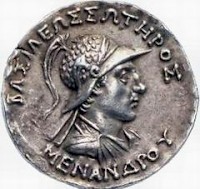
King Menander (c.125) reunited the Indo-Greek kingdom and even invaded the heartland of the contracted Mauryan empire, where he captured Patna. Menander is known from Indian sources as Minedra; one of the holy texts of Buddhism is called Milindapañha, "Questions of Menander".
However, the end of the Greek renaissance in Gandara was near. After Menander's death, his kingdom fell apart in at least forty petty kingdoms (their existence is known from coins). Before the end of the second century, several had been taken over by the Sacae.
This is the usual name for the nomad tribes of Central Asia, who always tried to invade the territories to their south, such as Bactria. They had been kept away since the age of king Cyrus, but had ravaged the Graeco-Bactrian kingdom in c.130 and had finally settled in Drangiana, which was henceforth called Sacastane or Sistan, its modern name. After 110, they launched raids on Gandara and infiltrated in the southern Indus valley.
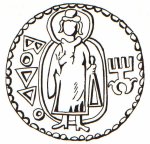
At the same time, the Parthians became interested in the region and started to take over the Greek petty kingdoms in Gandara. One of the Parthian leaders, living in Taxila, was named Gondophares; according to an old and wide-spread Christian tradition, he was baptized by the apostle Thomas. The story is not impossible: as we already noted, adherents of several religions lived together in Gandara and the Punjab, and there may have been an audience for a representative of a new Jewish sect.
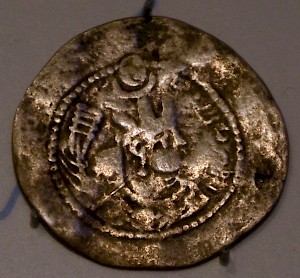
The Sacae and Parthians were still fighting for the possession of the remaining petty kingdoms, when the Yuezhi nomads (or Kushans) invaded. They were able to reunite the region, although it is not exactly clear when this happened. (The famous king Kanishka is possibly to be dated 127-170.) From their capital Peshawar in Gandara, the new kings ruled a powerful Buddhist empire, in which the Indian, Iranian, Sacan, Parthian and Greek elements were integrated.
It may be interesting to note that they were the first to make statues of Buddha, who was dressed in an Indian coat but standing like a Greek god. These statues were first made in Gandara. The most famous examples were those in the Bamyan valley (technically not in Gandara but Bactria), which were destroyed by the Taliban in the spring of 2001.